Posted on September 23, 2018
HP OmniBook 800CT
Following the HP 95, 100 and 200 series, HP’s calculator division devised the OmniBook 300, an ultra-light yet ultra-portable computer, the smallest of its time. Let’s have a closer look at a later generation model, the 800CT.
Quick Links:
Historic Overview
Since the initial release in 1993, the OmniBook has made quiet some developments. The first version ran on a 386 CPU and brought a companionship of software in ROM. In that respect similar to earlier HP 95 / 100 / 200 series, it was a huge leap forward, as it sported a fullsize keyboard and a fully VGA-compatible display. With it’s bundled set of DOS 5, Windows 3.1, Word and Excel, the OmniBook marked a milestone in mobile computing, today being attributed the first ever subnotebook.

HP Omnibook 800CT
One of the distinct feature of the OmniBook Series over all incarnations from the first 300 up to the latest 800 model, was the pop-out mouse. It was hidden in a small compartment on the right side of the notebook, and would pop-out upon an button press. This was very unique and distinct feature when compared to the usual trackball or trackpoint devices found in competing products.

OmniBook pop-out Mouse
The device in my collection is a 800CT, a later generation model of around 1996. While it’s no comparable match for the Toshiba Libretto 50CT in terms of size, the power lies elsewhere.
As it’s predecessors, it offers the unique pop-out mouse, a full size keyboard, a 800×600 capable SVGA color TFT display, and a quiet powerful Pentium MMX clocked at 166 MHz at it’s heart. With the still new MMX CPU causing lockups with the RTM version of Windows 95, the OmniBook was released with Windows 95, OEM Service Release 2. Long gone where the days of software in ROM, the 800 (as its intermedia predecessors) offered a built-in harddrive, to which the operating system, alongside with companion software, was installed.
Targeted at the business market, the OmniBook dock was available as an accessory, offering many connection offers for permanent desktop use, plus an internal expansion port, which could be fitted with either a 16bit ISA or a 32bit PCI adapter.
The optional floppy and CD-ROM drives being were built into external enclosures and could be connected to either the OmniBook or the dock. So with the choice to carry them along, or not, the OmniBook was a good match on the go.
Specs
The PHINTAGE Collection currently holds an HP OmniBook 800 CT.
| Vendor | Hewlett-Packard Company (HP, Inc, since 2015) |
| Model | OmniBook 800CT |
| Released | 1996 |
| Original Streetprice | TBD |
| Weight | TBD |
| Dimensions | 28cm x 18.5cm x 4cm |
| Builtin Display | 10.4″ TFT |
| Builtin Battery | yes |
| CPU | Intel Pentium MMX @166 MHz |
| RAM | 32 MiB (upgraded from stock 16 MiB) |
| Storage |
|
| Network Support | optional, via PCMCIA (or ISA/PCI in Dock) |
| USB | optional, via PCMCIA (or ISA/PCI in Dock) |
| Video Output | VGA |
| Other | 1 IrDA, 1 RS232, 1 Parallel Port, 1 VGA, 1 SCSI connector, 1 proprietary connector for Floppy Drive, Audio in/out, Mic in
Same set of ports, plus 2 additional PS/2 ports, and ISA/PCI extension capabilities using the Dock |
| Operating System | Windows 95, OEM Service Release 2 |
| Overall Condition |
|
| Restoration Parts needed |
|
Gallery
Coming soon.
Downloads
There is currently no downloads in this section.

I have the original install to factory settings CD Rom if anyone is interested in it. Just thought I would let others know. This is my favorite portable DOS Computer. I have the computer, Dock and CD Rom, only thing I am missing is the floppy drive and a power adapter for the Dock.
Hey Tom, I just acquired an Omnibook 800CT and would love a copy of the iso of the recovery cd if you could. Thanks!
Me too, I’d be interested into the recovery ISO 🙂
Hi I’ve just purchased one of these machines as yet I don’t know if it runs but fingers crossed! If I can get it running I’d also love a copy of the original build image